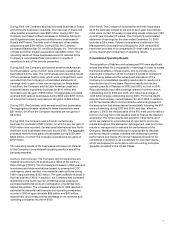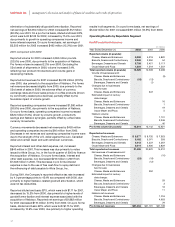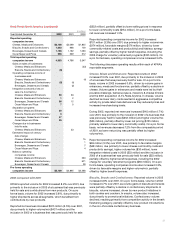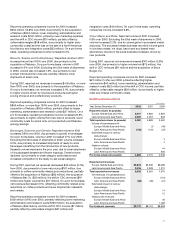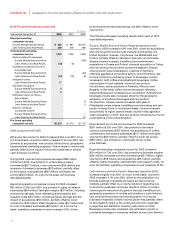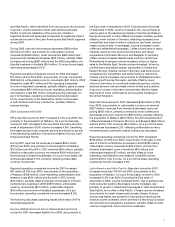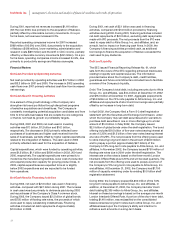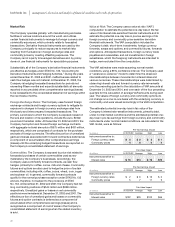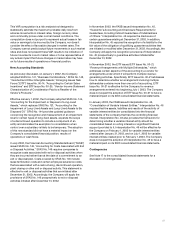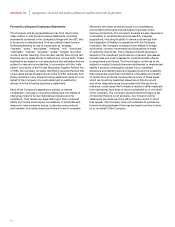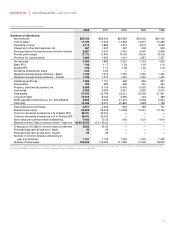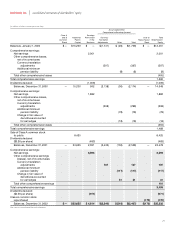Kraft 2002 Annual Report Download - page 42
Download and view the complete annual report
Please find page 42 of the 2002 Kraft annual report below. You can navigate through the pages in the report by either clicking on the pages listed below, or by using the keyword search tool below to find specific information within the annual report.
kraft foods inc. management’s discussion and analysis of financial condition and results of operations
During 2001, reported net revenues increased $1,116 million
(92.1%) over 2000, due primarily to the acquisition of Nabisco,
partially offset by unfavorable currency movements. On a pro
forma basis, net revenues increased 0.3%.
Reported operating companies income for 2001 increased
$189 million (100.0%) over 2000, due primarily to the acquisition
of Nabisco ($128 million), lower marketing, administration and
research costs ($89 million) and the shift in CDC income, partially
offset by unfavorable currency movements ($32 million). On a pro
forma basis, operating companies income increased 34.9%, due
primarily to productivity savings and Nabisco synergies.
Financial Review
Net Cash Provided by Operating Activities
Net cash provided by operating activities was $3.7 billion in 2002
and $3.3 billion in 2001 and 2000. The increase in 2002 operating
cash flows over 2001 primarily reflected cash flow from increased
net earnings.
Net Cash Used in Investing Activities
One element of the growth strategy of the Company is to
strengthen its brand portfolios through disciplined programs
of selective acquisitions and divestitures. The Company is
constantly investigating potential acquisition candidates and from
time to time sells businesses that are outside its core categories
or that do not meet its growth or profitability targets.
During 2002, 2001 and 2000, net cash used in investing
activities was $1.1 billion, $1.2 billion and $16.1 billion,
respectively. The decrease in 2002 primarily reflected lower
purchases of businesses and higher cash received from the
sales of businesses, partially offset by higher capital expenditures
related to the integration of Nabisco. The cash used in 2000
primarily reflected cash used for the acquisition of Nabisco.
Capital expenditures, which were funded by operating activities,
were $1.2 billion, $1.1 billion and $906 million in 2002, 2001 and
2000, respectively. The capital expenditures were primarily to
modernize the manufacturing facilities, lower cost of production
and expand production capacity for growing product lines. In
2003, capital expenditures are expected to be at or slightly
below 2002 expenditures and are expected to be funded
from operations.
Net Cash Used in Financing Activities
During 2002, net cash of $2.6 billion was used in financing
activities, compared with $2.1 billion during 2001. The increase
in cash used was due primarily to dividends paid during 2002
and repurchases of the Company’s Class A common stock.
During 2002, the Company issued $2.5 billion of global bonds
and $750 million of floating rate notes, the proceeds of which
were used to repay outstanding indebtedness. Financing
activities included net debt repayments of approximately
$1.5 billion in 2002.
During 2001, net cash of $2.1 billion was used in financing
activities, compared with $13.0 billion provided by financing
activities during 2000. During 2001, financing activities included
net debt repayments of $2.0 billion, excluding debt repayments
made with IPO proceeds. The net proceeds from the IPO were
used to repay debt to Altria Group, Inc. and affiliates, and, as
a result, had no impact on financing cash flows. In 2000, the
Company’s financing activities provided cash, as additional
borrowings to finance the acquisition of Nabisco exceeded the
cash used to pay dividends.
Debt and Liquidity
The SEC issued Financial Reporting Release No. 61, which
sets forth the views of the SEC regarding enhanced disclosures
relating to liquidity and capital resources. The information
provided below about the Company’s debt, credit facilities,
guarantees and future commitments is included here to facilitate
a review of the Company’s liquidity.
Debt: The Company’s total debt, including amounts due to Altria
Group, Inc. and affiliates, was $14.4 billion at December 31, 2002
and $16.0 billion at December 31, 2001. Aggregate prepayments
of $3.9 billion on the 7.0% note payable to Altria Group, Inc. and
affiliates and repayments of short-term borrowings were partially
offset by an increase in long-term debt.
In April 2002, the Company filed a Form S-3 shelf registration
statement with the Securities and Exchange Commission, under
which the Company may sell debt securities and/or warrants to
purchase debt securities in one or more offerings up to a total
amount of $5.0 billion. In May 2002, the Company issued
$2.5 billion of global bonds under the shelf registration. The bond
offering included $1.0 billion of five-year notes bearing interest at
a rate of 5.25% and $1.5 billion of ten-year notes bearing interest
at a rate of 6.25%. The net proceeds from the offering were used
to retire maturing long-term debt in the amount of $400 million
and to prepay a portion (approximately $2.1 billion) of the
Company’s 7.0% long-term note payable to Altria Group, Inc. and
affiliates. In November 2002, the Company issued $750 million of
floating rate notes due in 2004 under the shelf registration. The
interest rate on the notes is based on the three-month London
Interbank Offered Rate plus 0.20% and will be reset quarterly. The
net proceeds from the offering were used to prepay a portion of
the Company’s 7.0% long-term note payable to Altria Group, Inc.
and affiliates. At December 31, 2002, the Company had $1,750
million of capacity remaining under its existing $5.0 billion shelf
registration statement.
During 2002, the Company prepaid $3,850 million of the 7.0%
long-term notes payable to Altria Group, Inc. and affiliates. In
addition, at December 31, 2002, the Company had short-term
debt totaling $2,305 million to Altria Group, Inc. and affiliates.
Interest on these borrowings is based on the average one-month
London Interbank Offered Rate. A portion of the short-term debt,
totaling $1,410 million, was reclassified on the consolidated
balance sheet as long-term notes due to Altria Group, Inc. and
affiliates based upon the Company’s ability and intention to
refinance such amounts on a long-term basis.
38



